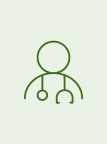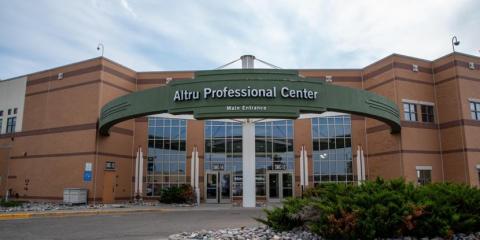Altru Orthopedics & Sports Medicine provides athletic training for school events and community sporting events in Grand Forks and surrounding regional communities.
Altru's athletic trainers are medical experts in preventing, recognizing and rehabilitating injuries that result from physical activity. They work with the athlete, family, school and coaching staff to return the athlete to regular play and normal life activities.
Altru's athletic trainers also specialize in concussion management and ImPACT testing.
For more information, please call 701.732.7700.
Altru's Athletic Trainers
Schools we currently serve at:
- Central Valley
- East Grand Forks
- Grand Forks Red River
- Landcaster
- Sacred Heart
- Tri-County
- Warwick
- Newfolden
- Lakota
- Dakota Prarie
- Grand Forks Central
- Kittson Central
- Larimore
- Stephen-Argyle
- Four Winds
- Devils Lake
- Lake Region State College
- Grand Forks Middle Schools (Twinning, valley, Schroeder and South)
Altru's Athletic Trainers are also available to provide athletic training services at community sporting events.
Athletic Training Facts
Athletic trainers know and practice health care at the highest professional, ethical and quality standards in order to protect the public.
Athletic training is practiced by athletic trainers, healthcare professionals who collaborate with physicians to optimize activity and participation of patients and clients. Athletic training encompasses the prevention, diagnosis, and intervention of emergency, acute, and chronic medical conditions involving impairment, functional limitations, and disabilities.
Athletic trainers are regulated and licensed health care workers.
While practice act oversight varies by state, athletic trainers practice under state statutes recognizing them as qualified health care professionals similar to physical therapists, occupational therapists and other health care professionals. Athletic training licensure/regulation exists in 47 states, with aggressive efforts underway to pursue licensure in the remaining states and to update outdated licensure. Athletic trainers practice under the direction of physicians.
More than 50 percent of athletic trainers work outside of school athletic settings; they provide services to people of all ages.
Athletic trainers work in physician offices as physician extenders. They also work in rural and urban hospitals, hospital emergency rooms, urgent and ambulatory care centers, military hospitals, physical therapy clinics, secondary schools, colleges/universities, youth leagues, commercial settings and professional sports teams. They are in great demand for their versatile health and wellness services and injury and illness prevention skills. As the United States continues its focus on reducing the effects of obesity and other chronic diseases, it is important that people have access to health care professionals who can support lifelong, safe physical activity.
Athletic Trainers improve patient functional and physical outcomes.
Results from a nationwide Medical Outcome Survey demonstrate that care provided by athletic trainers affects a significant change in all outcome variables measured, with the greatest change in functional outcomes and physical outcomes. The investigation indicates that care provided by athletic trainers generates positive change in health-related quality of life patient outcomes.
Heat Related Illnesses
Exertional Heat Stroke
Heatstroke is a severe heat illness that occurs when a child's body creates more heat than it can release, due to the strain of exercising in the heat. This results in a rapid increase in core body temperature, which can lead to permanent disability, or even death if left untreated.
Signs and Symptoms
- Increase in core body temperature, usually above 104°F/40°C (rectal temperature) when the child falls ill
- Central nervous system dysfunction, such as altered consciousness, seizures, confusion, emotional instability, irrational behavior or decreased mental acuity
Other possible indicators include:
- Nausea, vomiting or diarrhea
- Hot and wet or dry skin
- Dehydration
- Headache, dizziness or weakness
- Increased heart rate, decreased blood pressure or fast breathing
- Combativeness
Treatment
- Call emergency medical services for immediate transport or locate medical personnel.
- Remove extra clothing or equipment. Begin whole-body cooling with a tub of cool water, fans, ice or cold towels (replaced frequently)
Heat Cramps
Heat cramps are intense muscle spasms that occur after exercising for a while and losing large amounts of fluid and salt from sweating. While heat cramps are more common in children who perform in the heat, they can also occur when it's not hot (for example, during ice hockey or swimming).
Signs and Symptoms
- Intense pain (not associated with pulling or straining a muscle)
- Persistent muscle contractions that continue during and after exercise
Treatment
- The child should be given a sports drink to help replace fluid and sodium losses.
- Light stretching, relaxation and massage of the cramped muscles may help.
Heat Exhaustion
Heat exhaustion is a moderate heat illness that occurs when a child continues to be physically active even after suffering from ill effects of the heat, like dehydration.
Signs and Symptoms
- Child finds it hard or impossible to keep playing
- Loss of coordination, dizziness or fainting
- Dehydration
- Profuse sweating or pale skin
- Headache, nausea, vomiting or diarrhea
- Stomach/intestinal cramps or persistent muscle cramps
Treatment
- Move the child to a shaded or air-conditioned area
- Coll the child with cold water, fans or cold towels (replace towels frequently)
- If the child is not nauseated or vomiting, have him or her drink chilled water or sports drink
- Remove any extra clothing and equipment
- Have the child lie comfortably with legs raised above heart level
- the child's condition should improve rapidly, but if there is little or no improvement, take the child for emergency medical treatment
Dehydration
Dehydration is when your body is low in fluids (water) because you are not drinking enough to replace what is lost through sweat. This can cause you to perform poorly in sports.
Did you know that if you are between eight to fourteen years of age you could lose up to a quart of seat during two hours of activity on a hot day? That is the same amount as a carton of milk.
You can do three things to stop this from happening to you...drink, drink and drink. That's right. Drink before, during, and after your activity.
You can tell if you are dehydrated if you have these symptoms:
- Thirst, dry mouth
- Being irritable or cranky
- Feel like throwing up
- Dizziness, headache
- Cramps
- Weak or tired
What do you do if you begin to feel this way?
- Tell your athletic trainer or coach
- Take a time-out to rest
- Drink plenty of fluids
Your athletic trainer or coach will tell you when you are able to play again.
Sports Hygiene
Proper precautions are needed to minimize the spread of communicable diseases and skin infections darning athletics.
Universal Hygiene Protocol for Sports
- Shower immediately after every competition and practice
- Wash all workout clothing after each practice
- Wash personal gear weekly
- Do not share towels or personal hygiene products
- Refrain from full body cosmetic shaving
Infectious Skin Diseases
- An appropriate health care professional should evaluate any skin lesion before returning to competition.
Blood-borne Infectious Diseases
- An athletic with any amount of blood should leave the activity until the bleeding has stopped.
- In the event of contaminated surfaces, everything must be cleaned and disinfected.
Other Communicable Diseases
- Appropriate vaccinations of athletes, coaches and staff as recommended by the Centers for Disease Control (CDC)
- During outbreaks, please follow the guidelines set forth by the CDC, as well as state and local health departments.
Sports Injury Care and Prevention
R.I.C.E. = REST - ICE - COMPRESSION - ELEVATION
R= Rest
Resting an injured area is necessary to allow the body time to get the effects of the trauma under control and to avoid additional stress and damage to the injured tissue. The period of rest required will vary depending on the severity of the injury (e.g. days to weeks). People who do not rest an acute (sudden or traumatic) injury can prolong the inflammation period and increase the healing time required, thereby delaying the recovery.
I = Ice
Ice applied promptly to an injury can slow or minimize some of the inflammation. The cold causes a closing of the arterioles in the tissue, which reduces bleeding. The local tissue metabolism slows reducing its need for oxygen and nutrients, and the nerve imposes are slowed considerably to reduce the pain that's felt, providing a numbing effect. *Examples of ice treatment include using an ice bag or ice bucket for 15-20 minutes or ice massage for 7-10 minutes. Heat should only be applied after you are sure that the bleeding and swelling has stopped completely. Otherwise, an individual's recovery time will be delayed.
C = Compression
Compression is the application of an ace bandage or similar item around the injured area. This helps control swelling and provides mild support. Note: Any wrap should be applied carefully. Too tight a bandage could constrict or interrupt vital circulation to the area.
E = Evaluation
This involves raising the injured area above the level of the heart as much as possible. This position promotes the lessening or elimination of swelling through the use of gravity and lymph drainage system.
Prevention of sports injuries can be done through proper technique during play, proper equipment and training. The team at Altru Orthopedics & Sports Medicine can help to get you ready for your sport safely and effectively.





